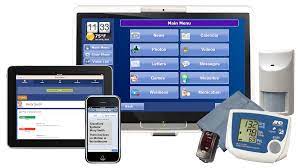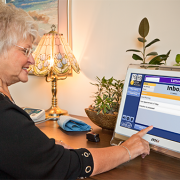Smart technology for seniors? Yes, it does exist.
Proactive versus reactive care is something that unfortunately too often becomes a hindsight 20/20 revelation for some elderly patients and their families. “If only we had known…” they would say. The truth is technology these days is not just good, it’s really good. Better than it was even just a few short years ago. The thing about technology is that it is always changing, evolving, and getting more sophisticated. That’s not to say that it is getting more complicated necessarily, in fact, in many cases the technology is actually getting easier to use. More hands free. Requiring even less for the user to do manually, with the advent of voice recognition, smart watches, and even artificially intelligent computers.
I mean, just a few years ago, it would have seemed unfathomable to think that you could talk into your phone, tablet, or computer to ask it a simple question and actually expect to get an intelligent response. Today, we can ask something as simple as “do I need an umbrella today?” and our technology device will actually give us a resonable answer related to our local weather report.
The same holds true for technology advancements in healthcare with virtual care services, and personal health/fitness monitoring devices. But did you know that there is even more advanced technology out there that is designed to help prevent hospitalizations, manage chronic conditions, and track daily activities, all to keep the elderly and disabled living independently for as long as possible in order to postpone the need for long-term care?
Introducing the grandCARE system. We provide a technology solution that benefits seniors, family caregivers, and professional senior care workers alike. It starts with our innovative touchscreen interface which has been carefully designed with the end-user in mind. It features large, easy-to-read icons and can be fully customized to include as few or as many menu options as desired. The platform is so intuitive to use, that no previous computer experience is required to enjoy.
The touchscreen can be use as key source of socialization, entertainment, and communication for the senior user with our integrated family Facebook photo sharing, video chatting, games, websites, news, weather and more available options.
Next, our passive activity and motion monitoring is an effective and unintrusive way to analyze patterns of behavior to become more aware when something isn’t quite right. Our sensors can detect when there is too much, too little or no motion, and alert when something out of the ordinary occurs. The alert rules can be established to send out a message by phone call, text, or email to one or multiple designated parties.
At grandCARE, we believe in not only helping seniors stay independent, but strive to enable them the ability to proactively manage their own health and wellness too. This is why we have available digital medical devices to take important health vital readings digitally using our innovative system. The data is captured on the system, and stored on our secure servers making the information accessible at anytime to a family member or professional care manager using our online based care portal. The information can be reviewed in report or chart format, and even exported as a PDF to send to a professional health care provider as well.
A recent article by Maryalene LaPonsie, featured in the U.S. News and World Report provides more support for the benefits that technology can have with seniors, families, and those in the long-term care industry.
For those who want to maximize their peace of mind, Gomez says the Cadillac of virtual long-term care is a remote-monitoring system like that offered by grandCARE.
With this system, activity sensors are placed in a senior’s home. To use grandCARE, Managed Senior Care first evaluates what a typical “good day” looks like for a senior and sets alerts accordingly. For example, if a senior typically has breakfast by 9 a.m. and the refrigerator hasn’t been opened by that time, an alert may go out to a caregiver.
As with Banner iCare, seniors using the grandCARE system are set up with a tablet. In this case, it’s an oversized tablet that can be remotely activated. If a caregiver needs to check on a senior, he or she can open Skype which will activate the camera and microphone on the tablet. At that point, the caregiver can look for the senior and call out to him or her to determine whether help is needed.
“One of the reasons we like this product is because it’s respectful of the senior,” Gomez says. “You know when people are watching. There is no secret monitoring.”
The article goes on to show how virtual care services are having an impact with both cost savings and patient outcomes:
“We save over $4,000 per patient per year and avoid hospital visits and readmissions,” Herzog says. From 2013 to 2014, Banner Health tracked the outcomes of newly enrolled Banner iCare members and compared that to claims data from the year before their enrollment. They found the program resulted in an overall 27 percent cost savings of $788 per patient per month. Hospitalizations also dropped from 11.5 per 100 patients per month in the year prior to enrollment to 6.3 per 100 patients per month six months after enrollment.
So, going back to where we started…”if only we had known.” Well, now you do.




